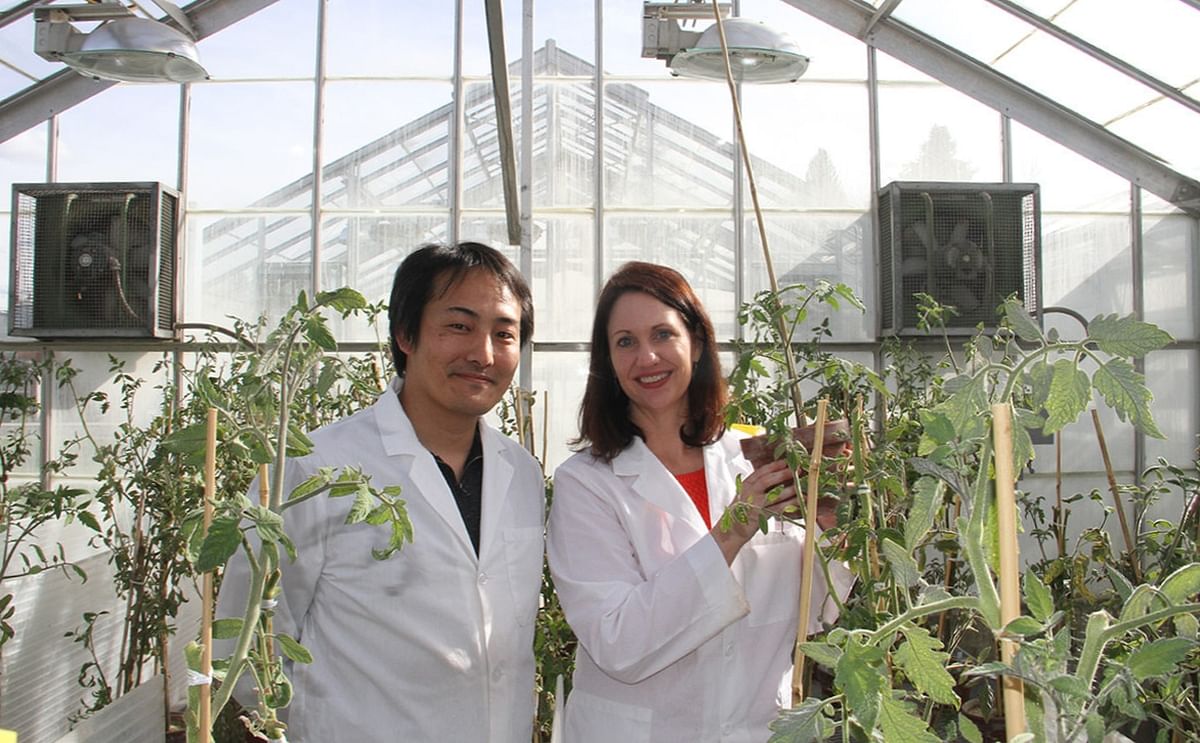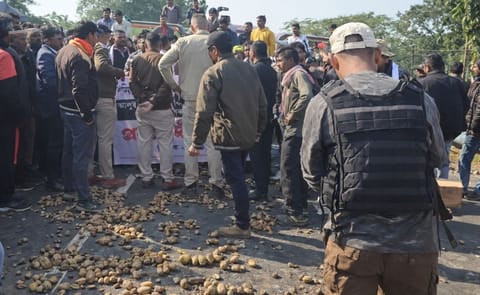Washington State University (WSU) plant pathologists Kiwamu Tanaka (left) and Cynthia Gleason (right) are exploring novel defenses against pest and diseases that harm valuable potato crops.
主标签
Looking for help in nature itself to defend potatoes against nematodes and scab

Helping safeguard the Northwest’s valuable potato crop from emerging threats—tiny, parasitic worms and a fungus-like pathogen that spreads a devastating virus—two scientists at Washington State University are launching new research this spring into better plant defenses based on genes and vaccines.
Washington state grows the most U.S. potatoes per acre, producing nearly $700 million worth of spuds per year. But the Northwest’s fourth most valuable crop is threatened by powdery scab, a disease caused by a fungus-like pathogen that also carries a harmful virus.
Potatoes are also under attack from Columbia root-knot nematodes, a microscopic worm found in Washington soils.
Funded by the U.S. Department of Agriculture’s Agriculture and Food Research Initiative (AFRI) and the Northwest Potato Research Consortium, plant pathologists Kiwamu Tanaka and Cynthia Gleason are exploring new molecular and living defenses against these pests.
A hidden threat
Neither fungi nor bacteria, the powder scab pathogen is a protist, from the same kingdom of life as slime molds and protozoa. Infecting roots and tubers of its potato host, powdery scab forms root galls that stop plants from drawing in nutrients and water. It also damages the tubers’ skin, turning potatoes ugly and unsellable.
Kiwamu Tanaka, assistant professor and phenomics researcher with the WSU Department of Plant Pathology:
Devastating yields, Potato Mop-Top Virus was first found in the U.S. in 2002, and is now starting to show up in the Northwest.
Kiwamu Tanaka:
Building on Gleason’s research into immunostimulants—special peptide compounds that spur a strong defense response in host plants—the two scientists will focus on a rod-shaped bacterium, or Bacillus,that colonizes the rhizosphere and secretes a compound that deters powdery scab.
Kiwamu Tanaka:
In addition to below-ground defense, Tanaka and Gleason will study the above-ground effects of their immunostimulant on plant growth and development, using new high-throughput phenotyping technology at WSU. This advanced technique precisely monitors the effects of the defender bacteria on factors like photosynthesis and water-use efficiency in potato seedlings and other model plants. The scientists will explore whether their approach has positive effects on plant growth.
Shutting the door on a tiny worm
Targeting another pest, Gleason, also an assistant professor of plant pathology, leads a three-year, $450,000 grant project funded by AFRI, launching this spring.
She is studying the molecular mechanisms of the root-knot nematode, a microscopic, parasitic worm that attacks plant roots and tubers.
Nematodes secrete proteins into plant cells that trick their hosts into providing them with a safe feeding site and plentiful nutrients, starving the plant. Above ground, infected plants sport wilted, discolored leaves. When farmers dig for potatoes, they discover lumpy, misshapen tubers.
Once she identifies how plants respond to nematode’s chemical secretions, she’ll have a starting point for new, gene-based defenses, such as new potato varieties that can resist the parasites.
Cynthia Gleason:
Cynthia Gleason:
Washington state grows the most U.S. potatoes per acre, producing nearly $700 million worth of spuds per year. But the Northwest’s fourth most valuable crop is threatened by powdery scab, a disease caused by a fungus-like pathogen that also carries a harmful virus.
Potatoes are also under attack from Columbia root-knot nematodes, a microscopic worm found in Washington soils.
Funded by the U.S. Department of Agriculture’s Agriculture and Food Research Initiative (AFRI) and the Northwest Potato Research Consortium, plant pathologists Kiwamu Tanaka and Cynthia Gleason are exploring new molecular and living defenses against these pests.
A hidden threat
Neither fungi nor bacteria, the powder scab pathogen is a protist, from the same kingdom of life as slime molds and protozoa. Infecting roots and tubers of its potato host, powdery scab forms root galls that stop plants from drawing in nutrients and water. It also damages the tubers’ skin, turning potatoes ugly and unsellable.
Kiwamu Tanaka, assistant professor and phenomics researcher with the WSU Department of Plant Pathology:
“Farmers struggle to control it, because fungicides don’t work very well.”Worse, scab also carries a virus, Potato Mop-Top Virus, or PMTV. A quarantine pathogen in some countries, the virus disrupts plant growth and causes tuber necrosis: edible potatoes die from the inside.
Devastating yields, Potato Mop-Top Virus was first found in the U.S. in 2002, and is now starting to show up in the Northwest.
Kiwamu Tanaka:
“The scary part is that until you dig up and cut into the potatoes, you don’t know it’s there.”Fighting powdery scab, Tanaka leads a three-year project, funded by a new $490,000 grant from AFRI and matching funds from the consortium. Assisted by Gleason, he is developing a biodegradable vaccine that can be delivered to the rhizosphere—the web of soil and living organisms in and around a plant’s roots.
“It can infect whole fields, but doesn’t show up above ground.”
Building on Gleason’s research into immunostimulants—special peptide compounds that spur a strong defense response in host plants—the two scientists will focus on a rod-shaped bacterium, or Bacillus,that colonizes the rhizosphere and secretes a compound that deters powdery scab.
Kiwamu Tanaka:
“We can use bacteria as a courier and defender to vaccinate the plant against both the protist and the virus.”Once perfected, this living defense could protect yields and keep fields in production, while helping farmers cut down on costly, often ineffective fungicides.
“The bacteria occupies the space and changes the microbiome, so the pathogen can’t take hold. At the same time, the plant is protected by immunization.”
In addition to below-ground defense, Tanaka and Gleason will study the above-ground effects of their immunostimulant on plant growth and development, using new high-throughput phenotyping technology at WSU. This advanced technique precisely monitors the effects of the defender bacteria on factors like photosynthesis and water-use efficiency in potato seedlings and other model plants. The scientists will explore whether their approach has positive effects on plant growth.
Shutting the door on a tiny worm
Targeting another pest, Gleason, also an assistant professor of plant pathology, leads a three-year, $450,000 grant project funded by AFRI, launching this spring.
She is studying the molecular mechanisms of the root-knot nematode, a microscopic, parasitic worm that attacks plant roots and tubers.
Nematodes secrete proteins into plant cells that trick their hosts into providing them with a safe feeding site and plentiful nutrients, starving the plant. Above ground, infected plants sport wilted, discolored leaves. When farmers dig for potatoes, they discover lumpy, misshapen tubers.
Once she identifies how plants respond to nematode’s chemical secretions, she’ll have a starting point for new, gene-based defenses, such as new potato varieties that can resist the parasites.
Cynthia Gleason:
“I’m trying to unravel how it works and find a way to block it.”Growers have long relied on chemicals to control nematodes. Similar to hers and Tanaka’s scab project, Gleason’s research helps give farmers a new, more sustainable tool for pest control.
“Stop the molecular mechanism, and the root-knot nematode can’t create its feeding site. If it can’t feed, it starves, and the plant thrives.”
Cynthia Gleason:
“We’re trying to reduce reliance on chemicals using biological and genetic controls, preserving beneficial organisms while helping feed the world.”
“It’s potentially a huge benefit for potatoes and other specialty crops, as well as human and environmental health.”
Like to receive news like this by email? Join and Subscribe!
Get the latest potato industry news straight to your WhatsApp. Join the PotatoPro WhatsApp Community!
精选企业
Sponsored Content
Sponsored Content
Sponsored Content
Sponsored Content










